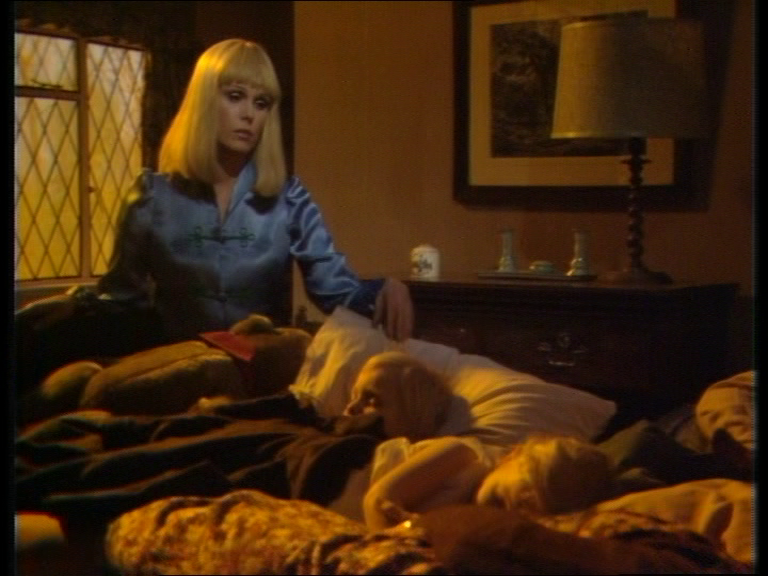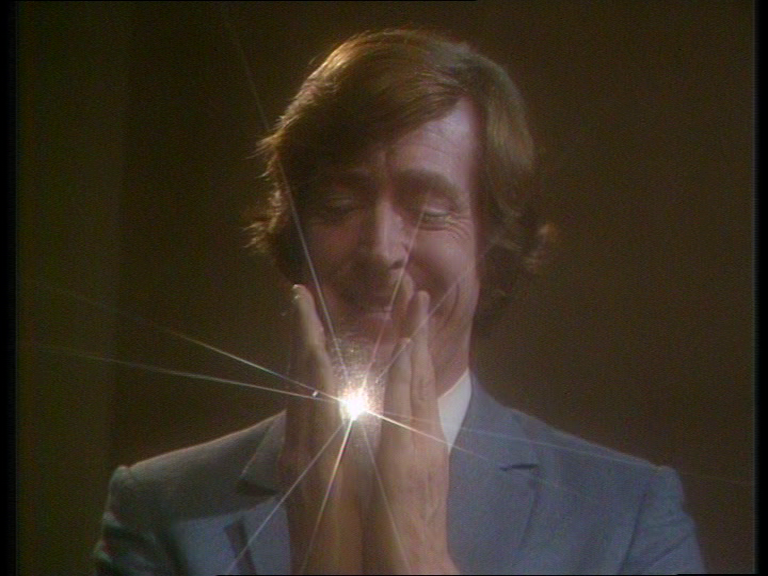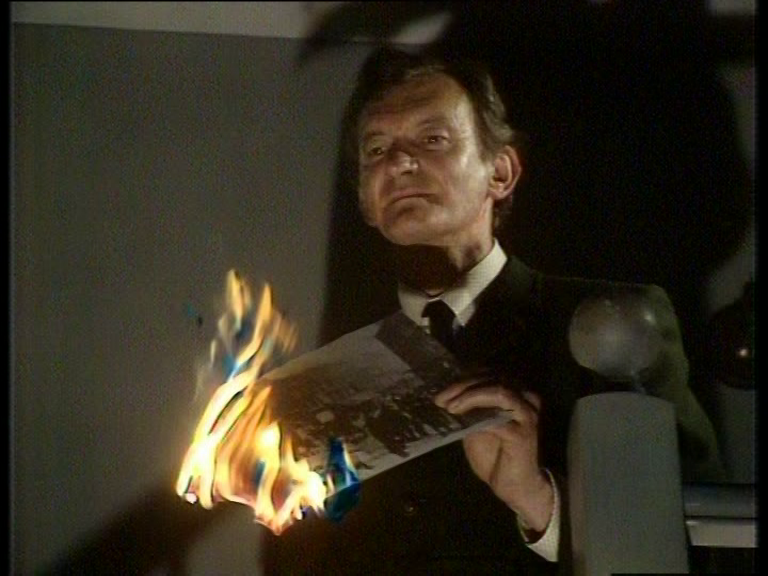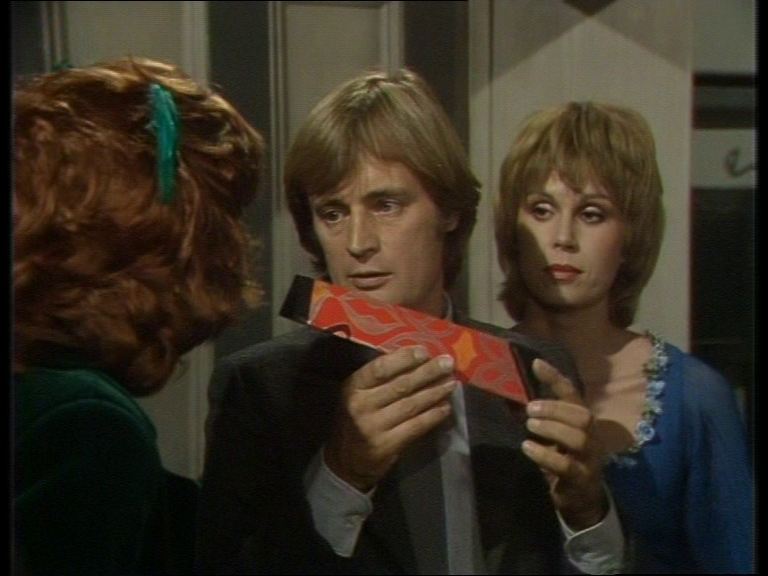At the end of March, I reviewed The Silver Archive #1A ̶ a monograph on Sapphire & Steel Assignments One and Two by the husband and wife team of Lesley and David McIntee. Although there is certainly much of interest within their work, it was hard to view it as anything but a muddled, carelessly written disappointment. Here, I consider the follow-up in Obverse’s series, The Silver Archive #1B, Sapphire & Steel Assignments Three and Four by Cody Schell.
Assignment Three concerns a mysterious sealed and invisible flat deposited in our time (well, 1980) by human researchers from 1500 years hence. A hostile entity within the flat has begun to attack its other occupants ̶ Eldred, Rothwyn, and a baby ̶ and the integrity of time is under threat. Sapphire and Steel, later joined by Silver, are assigned to investigate. In Assignment Four, Sapphire and Steel battle the Shape, a sinister, faceless man who traps people in photographs and has a band of sadistic Victorian children at his command. While Three is considered one of the weaker entries, many fans regard Four as the series’ acme: truly imaginative, taut, claustrophobic, and realised with very strong production values. Both stories provide ample material for discussion, which brings us to Schell’s work.
My first impression on reading Schell’s entry was that his prose is at least more fluent and less gangling than the McIntees’. Regrettably, the next thing to become apparent to me was that Schell isn’t in much of a hurry to talk about Sapphire & Steel. His Introduction begins with a fictionalised prologue set around a campfire, which he uses to say something, I think, about the nature of ghost stories. It’s profound. It must be; it’s in italics:
A really good story, told well, shuts everything else out. The words are just enough to make your own imagination do the work for the storyteller. The images in your own mind flicker in front of you and all else merges with the darkness. You drift away from the fire, but at the same time not away from it. You move in a direction that is somehow further away, and yet deeper within. The wood burns and glows like molten rock, deep within the Earth. And yet the fire is insubstantial and constantly in motion. Like the centre of a star.
Trillions of tons of screaming plasma, hundreds of times denser than water, four trillion PSI, at 15 million degrees Celsius. “Insubstantial.”

Schell then follows this with a passage that discusses the place of the story within human culture, its connections with our scientific understanding, and how this resulted in Sapphire & Steel. Well, it might do:
Just as chemical elements cannot be broken down into a more simple form, Sapphire & Steel tells mythological stories that focus on the bare core of storytelling, created in a raw, almost improvised way, combining story elements to discover what will happen.
Let’s at least marvel at the sheer argumentational labour that first, valiant little comma is doing. I imagine it would come as a surprise to P. J. Hammond, David McCallum, and the production team that the scripts they brooded over for months were created in a “raw, almost improvised way.”
We then commence with Chapter 1, in which Schell, in my opinion, mistakenly tries to evaluate Sapphire and Steel’s identity in scientific terms because the programme’s narration superficially sounds scientific. Yes, Sapphire and Steel are, within the stories, supposedly ‘elements,’ but we know that this is a nonsense. Neither steel nor sapphire are genuinely elements in real life. Neither is Jet, who is mentioned in the title sequence, nor ‘Wood’ or ‘Granite’, who were considered for an early draft of it. It makes much more sense to think of these designations as code names (as the character of Felix Harborough surmises in Assignment Five). There are no insights to be gained into Sapphire and Steel from an understanding of chemistry beyond the merely analogical: Steel is cold, grey, and hard; Sapphire is blue, beautiful, and multifaceted.

Despite this, Schell wastes our time with pages of fruitless cod science. His discussion of the periodic table and potted history of chemistry is self-indulgent, more than a little sophomoric, and certainly unreliable. He states, for example, that Aristotle “postulated the idea of four elements” when in fact that was Empedocles (494 – c. 434 BC), who died 50 years before Aristotle was born. Later, Schell states that the Aristotelian approach to the elements had been discarded “by the time of Christ.” If one assumes that to mean roughly 0 to 33AD, this is utter nonsense. In fact, it endured into the Renaissance. Even Antoine Lavoisier, generally regarded as the father of our modern understanding of chemistry, was still using remnants of the Aristotelian system as late as 1789. I’ll also note, in passing, that Schell repeats the McIntees’ misunderstanding of the Observer Effect in quantum theory.
In Chapter 2, Schell briefly leaves science to dress its wounds and turns his attention to Sapphire & Steel; breaking down the opening narration into four statements in order to analyse them. I won’t deal with this point by point, but a highlight is certainly his assertion that “existence is threatened by those things that don’t exist or can’t exist,” which at least demonstrates that Schell is not using the same language as the rest of us. It’s only a brief digression, however, as he soon embarks upon several pages of musings on relativistic physics, the nature of time, and more ramblings about the arrangement of elements. By the time I was reading sentences like “Diamond is an allotrope of Carbon but since the maths allows for all elements to have their own corresponding agent, we will assume this is the case and that Diamond does not represent Carbon,” my will to live was shrivelling in the forge of obstinate literalism. Not only is diamond not an element, Diamond is not even a character, merely a mention in the opening narration.

In Chapter 3, Schell begins talking about Sapphire & Steel again, with a discussion about the title sequence and earlier drafts of the narration. In Chapter 4, he discusses who Sapphire and Steel might be, what little we know of their origins, and whether they are human or alien. Here, he gives us some amiable enough speculations and throws in a quote or two from P. J. Hammond, who notes that he doesn’t really know who Sapphire and Steel are and doesn’t want to spoil the mystery by saying who they might be. There is little in these chapters with which I feel a need to argue. Much of it is simply the sort of musing or speculation one would find online among devotees of any genre show. As with the McIntees’ entry, Schell does make a number of points that one might charitably term ‘ambitious.’ For instance, while musing on the unseen ‘element’ Jet, he writes:
We don’t know much about Jet except that she’s female and paired with Lead… Is she African-American…? In America, Jet was the name of a magazine aimed at African Americans, seemingly named for the speed at which news travelled, and known for covering events in the Civil Rights Movement. Could this be the origin of the name of the element Jet? It’s potentially controversial to make this assumption and thus pair the two non-Caucasian agents together, but it remains a possibility suggested by the scripts.
Given that there is zero evidence of Jet’s ethnicity, I’d suggest that last sentence would read better if one replaced “potentially controversial” with “calamitously nonsensical.”
In another flight from plausibility, Schell wonders whether, when Steel takes off his jacket to investigate Williams’s photographic equipment in Assignment Four, this signifies that he is taking on the powers of another element. After all, the only other time Steel does this is in Assignment Three although, as Schell notes in the preceding paragraph, it “might simply suggest that what he is about to do is strenuous physical work.”
One point on which I will take issue is Schell’s contention that the Big Finish story Like Water from a Stone can “provide an insight into the nature of the agents.” Unlike the Doctor Who universe, where canon is pretty much what you want it to be (“I’m half human. On my mother’s side,” anybody?), with Sapphire & Steel authorial intent is almost undiluted. Except for Assignment Five, Hammond wrote them all and consciously chose not merely to preserve but to cultivate ambiguity. Therefore, and with no disrespect to Big Finish, while their work might offer an interpretation, it cannot offer “insight” (any more than their splendid reimagining of The Prisoner might tell us who Number One ‘really’ is). If Sapphire & Steel’s creator says he does not know ̶ and does not want to know ̶ the nature of his protagonists, then nobody does.

One of the fundamental problems with this volume (and its predecessor) is structure. Volume #2 is purportedly a discussion of Assignments Three and Four. Excluding front and back matter, bibliography, and so forth, it is 95 pages long. The first substantive discussion of Assignment Three does not begin until page 52. The section on Assignment Four begins on page 79 and continues to page 96. The remaining pages are given over to a comparison between Sapphire & Steel and the most recent Twin Peaks (I linked the two in my previous review, so here I credit Schell with eminent good sense and perspicacity). In other words, only 44 pages of this work is ̶ in my opinion ̶ substantively about Assignments Three and Four. Fully 51 pages are composed of a (faulty) history of chemistry, some observations and speculations about quantum theory and the periodic table, an analysis of the opening narration and titles, the origins of Sapphire and Steel, the possible nature of characters who never appear, and parallels with Twin Peaks. Overall, Schell talks around his brief more than about it.
This is all the more regrettable because, when he belatedly gets around to discussing Assignments Three and Four, Schell does have some interesting things to say. There are, for instance, some genuinely thoughtful speculations on the purposes of the capsules in Assignment Three. These capsules have never made sense in terms of their stated purpose (to have researchers from the future study life in the late 20th Century) as they also lock them in hermetically sealed invisible boxes so no actual contact with contemporary humans is possible. Schell offers a rationalisation that is thoughtful, if somewhat elaborate. But then he has some bizarre things to say. These range from the ungrammatical and wrong – “Computer programs are a kind of written language that functions on its own” – to the, I suppose technically correct, proposition that it is “not impossible” that the characters of Jade and Emerald in Twin Peaks’ faux soap Invitation to Love might be Lynch’s nod to Hammond. It remains, though, that the nuggets of interest must be picked out from a morass of shapeless filler.
The volume needs more coherency, as a whole and especially as the middle installment in a Sapphire & Steel trilogy. Sadly, most of the material in Chapters 3 and 4 would have better sat in the first volume. It would’ve been improved had Cody Schell dispensed with the amateur discussions of (quantum) physics and the ruminations on the periodic table. The piece could’ve been improved, too, if the volume ended with a proper conclusion, rather than a lengthy digression into Twin Peaks that does not finish but merely stops. Quite literally, the closing paragraph of Schell’s book on Sapphire & Steel Assignments Three and Four is:
On Twin Peaks 2017, processed meat also triggers a mental breakdown in a character, Sarah Palmer, mother of Laura. While at the grocers, stocking up on alcohol with which to numb herself from other psychic forces, Sarah is very upset by rows of beef jerky and turkey jerky on display. It is easy to dismiss this as just camp kitsch, an attempt by Lynch to place turkey jerky into the same context as cherry pie and doughnuts, but it can also be seen as a treatment of animal flesh as a symbol of domestic violence, a kind of murder made commonplace and accepted. Which is it?
It’s both.
The seeming lack of care and basic professionalism (in both volumes) is genuinely dispiriting. Cody Schell is clearly intelligent and perceptive, and I do not deny that, for a few precious pages, every so often, I did find his work interesting. But the cost, in wading through page after page of irrelevance, error, and bunkum, was too high.
The Silver Archive #2A by Cody Schell is available from Obverse Books, priced £5.99.